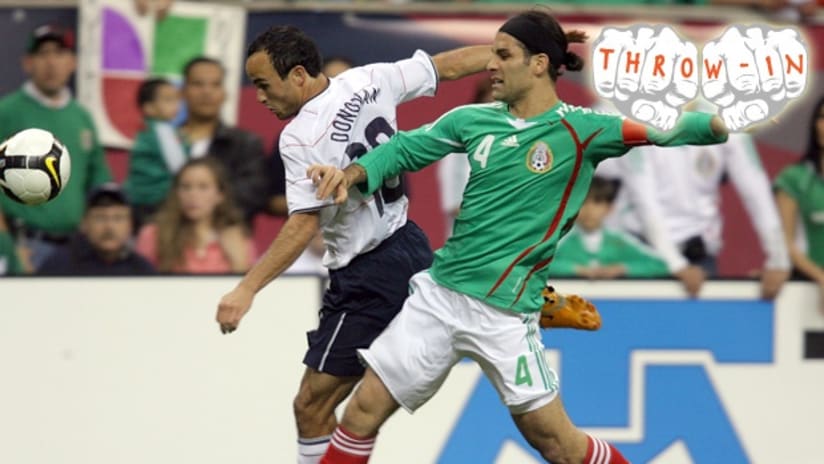Major League Soccer’s goal is to be the dominant league in the region, right? That’s what we hear every time an MLS team signs a big-name player, every time MLS teams line up in anticipation of chasing the crown in CONCACAF Champions League play.
We all know that race consists of only two horses: MLS and Mexico’s Primera División. If you go by the metric of the Champions League, Mexico won the battle yet again. But MLS is winning the war.
I had been anticipating the release of the rosters for next month’s CONCACAF Gold Cup for weeks because I had a feeling MLS players would make their national teams in close to record numbers. Sure enough, MLS dominated as far as representation. But it wasn’t just domination. Major League Soccer crushed as far as sending its players to the region’s top tournament.
A record 32 MLS players will be suiting up for their countries next month. That’s a number that has been trending upward steadily since the league’s founding, so it’s not a huge surprise that this league is carrying the flag — literally, on players’ sleeves — in CONCACAF.
Players in Gold Cup
Year |
MLS |
Mex. PD |
1996 |
3 |
24 |
1998 |
22 |
22 |
2000 |
19 |
23 |
2002 |
22 |
23 |
2003 |
19 |
19 |
2005 |
28 |
23 |
2007 |
23 |
18 |
2009 |
29 |
29 |
2011 |
32 |
17 |
What is surprising is the scope and magnitude of how prolific MLS has become. All but two of the 12 Gold Cup teams have at least one MLS representative, something that’s unprecedented in the history of the tournament. (The only holdouts are Panama, who don’t have a single player currently in MLS, and Cuba, where you’re out of the picture if you leave the motherland behind.)
"The fact that many of the different countries have more MLS players shows that guys want to come to the MLS,” Colorado defender and Jamaica veteran Tyrone Marshall tells MLSsoccer.com. “It's a very competitive league, a strong league and it's stepping up. The Gold Cup is going to help that."
The 36-year-old Marshall will play in his fourth Gold Cup for Jamaica, who have, by the way, the most MLS representation of any team on their roster with nine players. The US are right behind with seven, followed by Canada with six.
Flip that around to the league level, and all but three MLS clubs are represented across Gold Cup rosters. That’s never happened before either, and more impressive when you consider that with 18 teams, there’s a bigger pool from which to pick.
But there’s one more metric that’ll knock your socks off. As far as single representation from one league, that stat of 32 MLS players blows everyone else out of the water. Sure, Cuba’s 23-man roster all comes from the Cuban league. And El Salvador and Honduras both count 20 players from their own domestic leagues. But that’s not with whom MLS is competing.
The Mexican Primera División has only 17 representatives across rosters: 14 on Mexico, one on Honduras (Carlo Costly), one on Panama (Felipe Baloy) and one on the US (Jonathan Bornstein). That marks a record low for Mexico since MLS’ founding, and the fourth straight Gold Cup in which MLS has more representation than the Mexican top flight.
Does that mean MLS is better than Mexico? On its own, no. Europe’s big leagues are still the standard-bearer for international play, and El Tri count eight players on their 23-man roster who play in England, Spain, the Netherlands and Scotland. (Even MLS’ lone representative, El Tri captain Rafa Márquez, won’t get suckered into the MLS-vs.-Mexico debate.)
But the prevailing winds now are that for all players from CONCACAF nations, the best opportunities are in MLS. That means the best competition, the best physical tests of ability, the best exposure and, most importantly, the best way to translate your skills to the international level. That extends all over the region, from North America’s giants, to the underrated Central American powers, to the diamond-in-the-rough Caribbean.
"The league is growing, it's evolving,” says Marshall. “There are a lot of MLS players who are eager to step onto the international stage. Coaches are becoming more and more comfortable picking players from the MLS."
We have a funny cliché here at the MLSsoccer.com offices that “a rising tide lifts all boats.” In our world, that means that when fans visit the websites of all 18 MLS clubs, it benefits the league website, and vice versa. But it’s an apt phrase for MLS and CONCACAF, too.
As MLS stretches its wings across the region, it’s helping to make all of CONCACAF better — and the reverse is also true. And perhaps most selfishly — and adding another little barb to the US-Mexico rivalry — it shows this league has another leg up on our South of the Border neighbors.
Bring on the Gold Cup.
Jonah Freedman is the managing editor of MLSsoccer.com. “The Throw-In” appears every Thursday.


